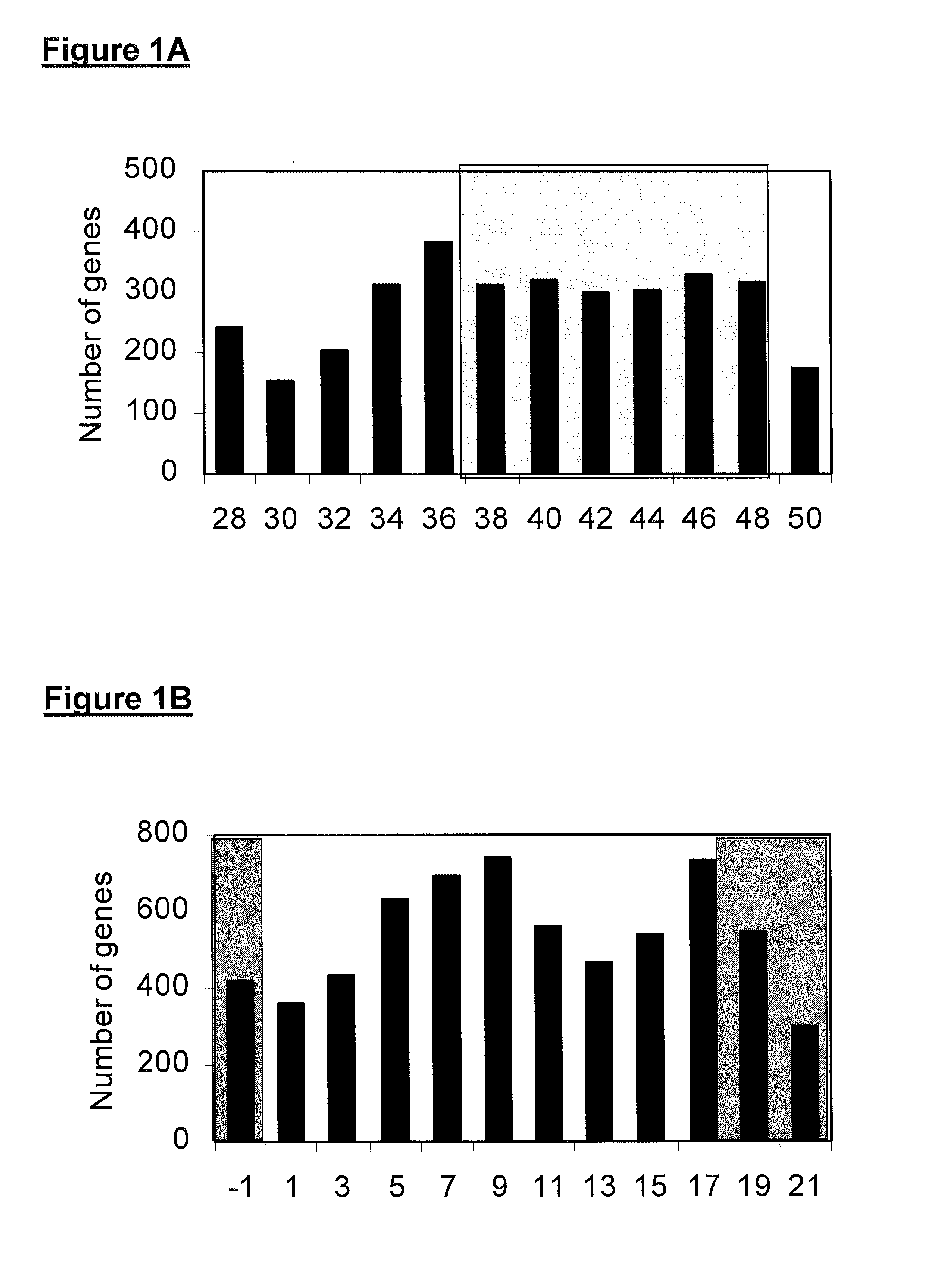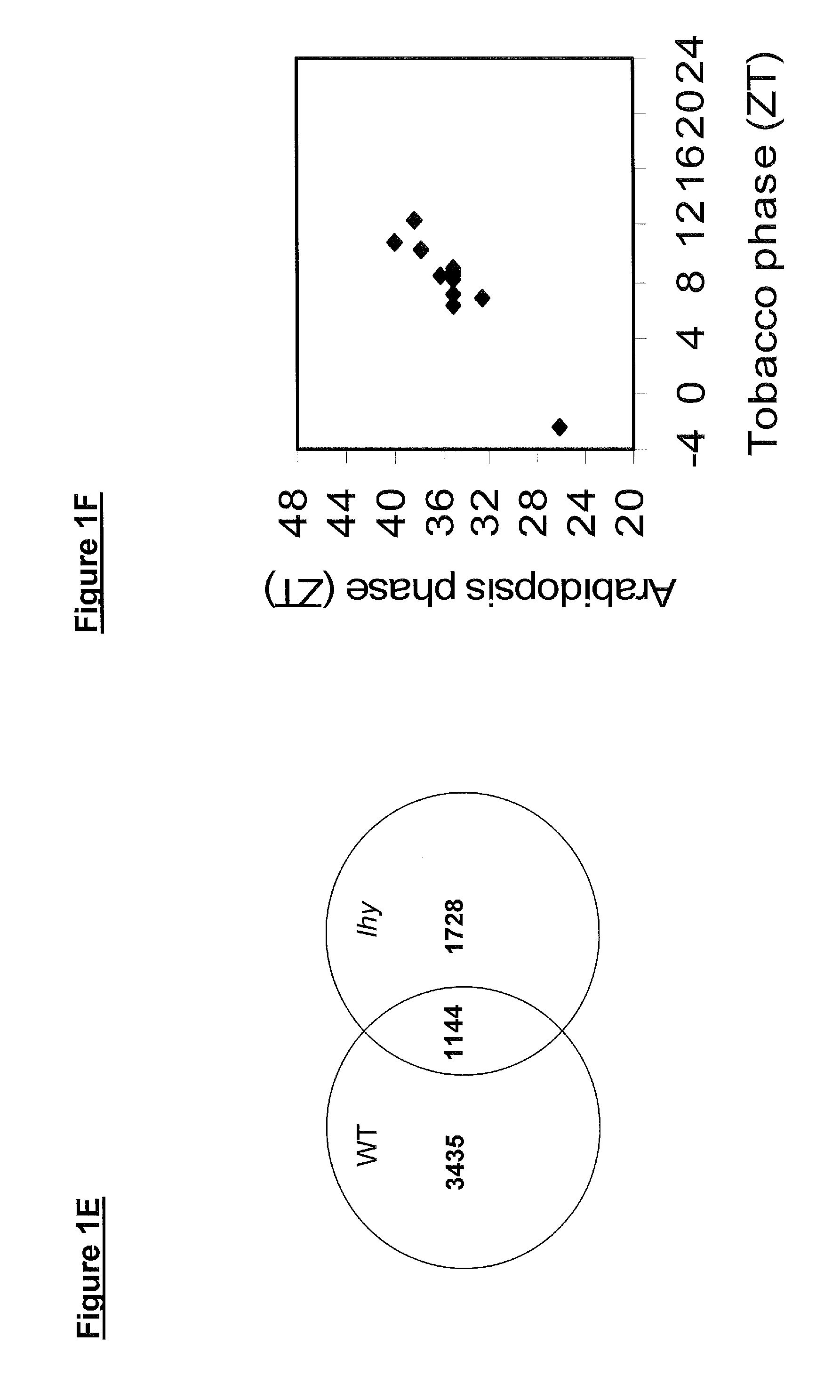Transgenic plants having altered lignin density
a technology of lignin density and transgenic plants, which is applied in the field of transgenic plants having altered lignin density, can solve the problems of affecting the flavour of inhaled smoke, the inability of trees grown in such sub-optimal conditions to fully develop, etc., and achieves the effects of increasing decreasing the concentration and/or activity of polypeptides, and increasing the density of lignin in plants
- Summary
- Abstract
- Description
- Claims
- Application Information
AI Technical Summary
Benefits of technology
Problems solved by technology
Method used
Image
Examples
example 1
Analysis of Rhythmic Gene Expression in Arabidopsis, Tobacco and Poplar Plants
[0106]To determine whether rhythmic regulation of individual core circadian clock and circadian rhythm regulated genes was conserved across species, a comparison, over time, was made with orthologous genes expressed in Arabidopsis, tobacco and poplar plants. Gene expression in these plants was determined by microarray analysis and the results are shown in FIGS. 1A-D.
Growth Conditions
[0107]Rooted cuttings of in vitro cultivated Poplar wild-type and lhy-10 RNAi lines, as described in Example 2, were potted in a 3:1 mix of fertilized peat and perlite. Poplar plants were grown under 18-hour light / 6-hour darks of 200 mol m−2 s−1 at 18° C. and 80% relative humidity. Tobacco plants were grown under cycles of 18-hour light and 6-hour dark for 54-56 days. Arabidopsis plants were grown under cycles of 12-hour light and 12-hour dark cycles for 9-10 days.
Isolation of Plant Tissue and RNA Extraction
[0108]Tissue samples...
example 2
Generation of Transgenic Poplar lhy-10 Plants
[0116]The gene LATE ELONGATED HYPOCOTYL1 is known. It is expressed in Arabidopsis and codes for a transcription factor that regulates the transcription of circadian rhythm regulated genes. Molecular studies on Populus tremula×P. tremuloides have identified LHY1 and LHY2 as core circadian clock genes which enable poplar plants to adapt their local environment by regulating the expression of other rhythmically expressed genes and altering their perception of photoperiod (day length). LHY1 and LHY2 are crucial for aligning major growth events with long days and warm temperatures in spring and summer, and the ability to obtain freezing tolerance during dormant periods.
[0117]In order to study the effect of the circadian rhythm on the growth and development of poplar plants, a transgenic poplar plant cell line, referred to as lhy-10, which exhibits significantly reduced expression of both LHY1 and LHY2 genes compared to its wild-type poplar pla...
example
Analysis of Rhythmic Gene Expression in Wild-Type and lhy-10 Poplar Plants
[0123]As shown in Table 2, some biological activities, such as Abscisic acid responses and preparation for photosynthesis, are conserved across the different species of plant, to specific times of the day.
TABLE 2Biological activities regulated by the circadian rhythmof Arabidopsis, Tobacco and Poplar plants.Zeitgebertime(hours)ArabidopsisTobaccoPoplar0-4Abscisic acidAbscisic acidPreparation forresponsesresponsesphotosynthesisPreparation forRegulation of cellphotosynthesisdivisionPhenylpropanoidNitrogenbiosynthesisassimilation / metabolism4-8Long dayLong dayRed and far red lightphotoperiodismphotoperiodismresponsesCarbohydratePhotosynthesisPentose PhosphatemetabolismGrowth?shuntPhotosynthesisBrassinosteroidLipid binding andrelatedbiosynthetic processtransportWater channelPhotosynthesisactivityResponse to sugarsCell wallmodificationStress responses(drought, high lightintensity 8-12Response to coldResponse to cold,...
PUM
| Property | Measurement | Unit |
|---|---|---|
| humidity | aaaaa | aaaaa |
| diameters | aaaaa | aaaaa |
| time | aaaaa | aaaaa |
Abstract
Description
Claims
Application Information
 Login to View More
Login to View More - R&D
- Intellectual Property
- Life Sciences
- Materials
- Tech Scout
- Unparalleled Data Quality
- Higher Quality Content
- 60% Fewer Hallucinations
Browse by: Latest US Patents, China's latest patents, Technical Efficacy Thesaurus, Application Domain, Technology Topic, Popular Technical Reports.
© 2025 PatSnap. All rights reserved.Legal|Privacy policy|Modern Slavery Act Transparency Statement|Sitemap|About US| Contact US: help@patsnap.com



